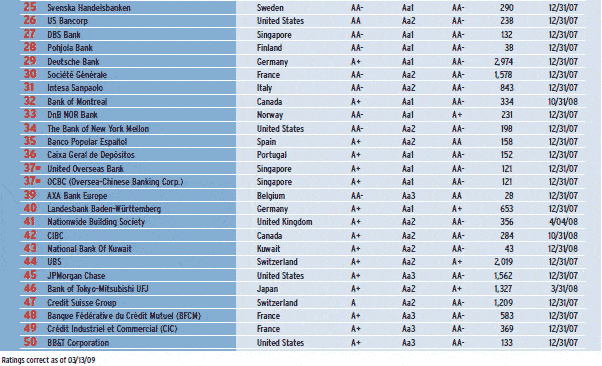ANNUAL SURVEY/ SAFEST BANKS MID-YEAR UPDATE
Global Finance selects the world’s safest banks, the 50 institutions with the highest ratings from the leading credit ratings agencies.
 Such has been the turmoil in the world’s banking industry that Global Finance is publishing a mid-year update of its Safest Banks listing. That this is a period of unprecedented upheaval is amply illustrated by the fact that this list includes 13 newcomers—which means more than one-fifth of last year’s safest banks have seen their prospects decline enough since mid-2008 to send them tumbling off the list. Among those new to the safest banks list is Finland’s Pohjola Bank, which vaulted into 28th place, with an aggregate credit rating score that matches Britain’s HSBC, one of the largest banks in the world. Also new to the list—and neck-and-neck in 37th place—are Singapore’s OCBC and United Overseas Bank, each achieving identical credit ratings to German banking giant Deutsche Bank and Canada’s Bank of Montreal.
Such has been the turmoil in the world’s banking industry that Global Finance is publishing a mid-year update of its Safest Banks listing. That this is a period of unprecedented upheaval is amply illustrated by the fact that this list includes 13 newcomers—which means more than one-fifth of last year’s safest banks have seen their prospects decline enough since mid-2008 to send them tumbling off the list. Among those new to the safest banks list is Finland’s Pohjola Bank, which vaulted into 28th place, with an aggregate credit rating score that matches Britain’s HSBC, one of the largest banks in the world. Also new to the list—and neck-and-neck in 37th place—are Singapore’s OCBC and United Overseas Bank, each achieving identical credit ratings to German banking giant Deutsche Bank and Canada’s Bank of Montreal.
Perhaps unsurprisingly, the top-10 has seen some significant changes, too. Newly arrived in the top echelon of the world’s safest banks, for example, are Royal Bank of Canada and Spain’s Banco Santander. Both are recognized for having taken a more cautious approach to risk than some of their competitors, and amid the turmoil of the past two years, that approach has clearly paid off.
There are also some banks that have seen their ranking among the world’s safest barely change over the past year, showing they, too, are reaping the benefits of effective risk management.
JPMorgan Chase actually managed to clamber up one place and Deutsche Bank held its position at number 29, both banks starkly outperforming rivals such as Bank of America, Citi, Barclays and Royal Bank of Scotland, which all lost their places among the world’s safest banks.
Because bank safety is such a key concern at present, we are awarding, for the first time, an honorable mention to two banks that did not make it into the top 50—National Bank of Abu Dhabi and Northern Trust. These banks’ aggregate credit ratings were the same as those banks toward the bottom of the safest 50, but their total assets were lower, so they did not make it into the top 50.
As always, we have constructed our ranking based on size and credit quality. We began with a pool of the world’s 500 largest banks by asset size, to which we applied the most recent available ratings from Fitch Ratings, Moody’s Investors Service and Standard & Poor’s, with appropriate weightings. Where banks were rated equally by all three ratings agencies, the largest of the banks was awarded the highest ranking.



By Dan Keeler



